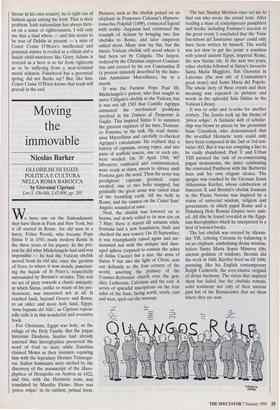Moving the immovable
Nicolas Barker
GLI OBILISCHI EGIZI: POLITICA E CULTURA NELLA ROMA BAROCCA by Giovanni Cipriani Leo S. Olschki, L45, 000, pp. 205 We have one on the Embankment, they have them in Paris and New York, but it all started in Rome. An old man in a hurry, Felice Peretti, who became Pope Sixtus V in 1585, made modern Rome in the three years of his papacy. In the pro- cess he did what Michelangelo had said was impossible — he had the Vatican obelisk moved from its old site, once the gardens of Nero, to where it now stands, punctuat- ing the façade of St Peter's, respectfully surrounded by Bernini's arcades. This was no act of piety towards a classic antiquity, in which Sixtus, unlike so many of his pre- decessors, was interested not at all. It reached back, beyond Greece and Rome, to an older and more holy land, Egypt, `terra bagnata del Nilo', as Cipriani repeat- edly calls it in this wonderful and evocative book.
For Christians, Egypt was holy, as the refuge of the Holy Family. But the pagan historian Diodorus Siculus had already asserted that hieroglyphics preserved the word of God to man, while Eusebius claimed Moses as their inventor, equating him with the legendary Hermes Trismegis- tus. Italian humanists were excited by the discovery of the manuscript of the Hiero- glyphica of Horapollo on Andros in 1422, and this, with the Hermetic texts, was translated by Marsilio Ficino. Here was prisca religio' in its earliest, primal form. Pictures, such as the obelisk poised on an elephant in Francesco Colonna's Hypnero- tomachia Poliphili (1499), connected legend with reality. Augustus had celebrated the triumph of Actium by bringing two fine obelisks to Rome, and later emperors added more. Many now lay flat, but the future Vatican obelisk still stood where it had been set by Caligula. The largest, ordered by the Christian emperor Constan- tine and erected by his son Constantius II (a process minutely described by the histo- rian Ammianus Marcellinus), lay in a marsh.
It was the Farnese Pope Paul III, Michelangelo's patron, who first sought to move Caligula's obelisk to the Vatican, but it was not till 1583 that Camillo Agrippa estimated the mechanical problems involved in his Trattato di Trasportar la Guglia. This inspired Sixtus V to summon the greatest engineer of his time, Domeni- co Fontana, to the task. He read Amrni- anus Marcellinus and carefully re-checked Agrippa's calculations. He realised that a battery of capstans, strong ropes, and two pairs of scaffold towers, one at each site, were needed. On 30 April 1586, 907 labourers, confessed and communicated, were ready at dawn, sworn to silence until Fontana gave the word. Then the noise was prodigious: capstans groaned, ropes creaked, one or two bolts snapped, but gradually the great stone was raised clear of the trembling earth. All the bells in Rome, and the cannon on the Castel Sant' Angelo, sounded at once. Next, the obelisk was lowered on to beams, and slowly rolled to its new site on 7 May; there it stayed till autumn while Fontana laid a new foundation, built and checked the new towers. On 10 September, it was triumphantly raised again and sur- mounted not with the antique and dam- aged sphere (reputed to contain the ashes of Julius Caesar) but a star, the arms of Sixtus V but also the light of Christ, sent out defiantly to the four corners of the world, asserting the primacy of the Counter-Reformist church over the gen- tiles, Lutherans, Calvinists and the rest. A series of splendid inscriptions on the four sides of the base, facing north, south, east and west, spelt out the message. The late Stanley Morison once set me to find out who wrote the actual texts. After reading a mass of contemporary pamphlets and books, including Fontana's account of the great event, I concluded that the 'Varie Inscrittioni del Santissimo signor' could only have been written by himself. The world was not slow to get the point: a seamless web joined ancient Egypt, imperial Rome, the new Sistine city. In the next two years, other obelisks followed at Sixtus's favourite Santa Maria Maggiore, San Giovanni in Laterano (the new site of Constantine's great stone) and Santa Maria del Popolo. The whole story of these events and their meaning was repeated in pictures and words in the splendid Sala Sistina in the Vatican Library.
It was to echo and re-echo for another century. The Jesuits took up the theme of `prisca religio'. A fantastic web of scholar- ship was blown to pieces by the protestant Isaac Casaubon, who demonstrated that the so-called Hermetic texts could only have been composed in the 2nd or 3rd cen- turies AD. But it was too tempting a line to be easily abandoned. Paul V and Urban VIII pursued the task of re-consecrating pagan monuments, the latter celebrating the renovated Pantheon with the Barberini bees and his own elegant alcaics. The apogee was reached by the German Jesuit Athanasius Kircher, whose celebration of Innocent X and Bemini's obelisk fountain in the Piazza Navona was inspired by a vision of universal wisdom, religion and government, in which papal Rome and a Habsburg Holy Roman Empire were unit- ed. All this he found revealed in the Egyp- tian hieroglyphics which he interpreted in a host of learned books.
The last obelisk was erected by Alexan- der VII, echoing Colonna by balancing it on an elephant, symbolising divine wisdom, before Santa Maria Sopra Minerva (the ancient goddess of wisdom). Bernini did the work in 1666. Kircher lived on till 1680, pursuing, like his English contemporary Ralph Cudworth, the ever-elusive original of divine harmony. The vision that inspired them has faded, but the obelisks remain, solid testimony not only of their ancient past but of the Renaissance that set them where they are now.


















































 Previous page
Previous page